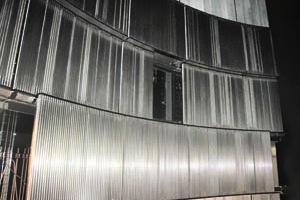
Neutron scattering is a powerful tool for studying the strength of the magnetic interactions between a material’s magnetic ions. A collaboration from Canada, Taiwan, and the United States used time-of-flight neutron scattering at the Spallation Neutron Source instrument SEQUOIA to detect and measure the magnetic excitations in a 1-dimensional, magnetic chain-like system in which the lattice spontaneously distorts, pointing to alternating magnetic interaction strengths between the ion pairs.
Such a phenomenon is known as a “spin-Peierls” phase transition. “These materials exhibit unusual low-dimensional magnetic properties,” says Patrick Clancy, a Ph.D. student at McMaster University in Hamilton, Ontario. “Such low-dimensional systems in general can give rise to very interesting and exotic physics, particularly at low temperatures. In addition, they are very useful model systems—both because they exhibit such a rare phase transition and because physics in one dimension is much easier to treat theoretically and computationally.”
The general interest in these materials is largely in the pure physics, Clancy explains. “The combination of low dimensionality, strong coupling between magnetism and structure, and small quantum mechanical magnetic moments can give rise to very interesting and exotic behavior.
The 1-dimensional material is TiOBr, a titanium oxyhalogen. The team used the fine-resolution Fermi chopper spectrometer SEQUOIA to take the measurements. They discovered two branches of magnetic excitations in the material, which they associate with singlet to triplet excitations in the spin-Peierls ground state. Where it occurs, such magnetic behavior opens an energy gap between the ground state and the “spin waves” in the higher excited states. This research represents the first direct measurement of the energy gap between the singlet ground state and the first triplet excited state in TiOBr, one of the most fundamental properties of a spin-Peierls system. The researchers hope these results will help to guide and inform future studies of these novel magnetic systems.
In the past, neutron scattering measurements have not been reported for TiOBr or TiOCl (its closely related sister compound), as the available single crystal samples have been too small. In addition, because of the small magnetic moments in the system, the magnetic scattering from the sample is too weak. As a result, there has been a surprising lack of information about the magnetic excitation spectrum of these unconventional systems. SEQUOIA is an ideal instrument to study weak magnetic scattering, offering both high neutron flux and excellent low-Q detector coverage.
TiOBr belongs to a select family of magnetic materials that possess a combination of small magnetic moments, short-range antiferromagnetic interactions, and strong coupling between the magnetism and the atomic positions. At the phase transition temperature, uniform one-dimensional chains of equally spaced magnetic atoms (with separations a a a a) distort to form dimerized chains where neighboring atoms draw closer together and pair up (with separations a b a b a b a b). These “alternating chains” exhibit very different magnetic properties from the uniform chains. Very few materials have been found to undergo this type of phase transition to an inherently quantum state of matter, and there are currently only three known inorganic spin-Peierls systems: CuGeO3, TiOCl, and TiOBr.
The results are quite surprising, as it is dramatically larger than the energy gaps observed in other spin-Peierls systems and much bigger than the standard Bardeen, Cooper, and Schrieffer theoretical model would predict. The bandwidth of the excitations is narrow compared with the size of the energy gap, suggesting that the excited triplets are well localized. Furthermore, the researchers can infer that the interactions between the excited triplets are very weak.
Research at the SNS at Oak Ridge National Laboratory was sponsored by the Scientific User Facilities Division, Office of Basic Energy Sciences, U.S. Department of Energy. ORNL is managed by UT-Batelle, LLC, under contract DE-AC0500OR22725 for the U.S. Department of Energy.
>Research Contact: Patrick Clancy, McMaster University

